You pass by that big tube thing in the basement with a water filter in it and say to yourself, I haven’t changed that filter in a while, what did it look like, which type of new filter do I need to get? Is the filter in it now the right one for my house?
What water filter do I need for my house? Homes with private wells should have a sediment filter for removal of sediment that may come up from the well. Municipally supplied water should be treated with a Granular Activated Carbon (GAC) filter for removal of disinfectants used to make the water safe to consume.
One filter says cellulose, the next says pleated polyester, and yet another looks like a ball of yarn that has been stretched out. They look so different and have all kinds of descriptions, let’s look into what your water situation is, and what whole house water filter should be best for you.
Types of home water filters, what they are for, and why you should use them.
First a quick lesson about microns!
A Micron or (Micrometre/Micrometer) is a measure of length equal to one-millionth of one metric meter. A Micrometre is represented by the symbol μm.
The length of a Micrometre is so small that a single human hair can range from 17 to 181 μm (Microns) in diameter (width).
A single piece of paper will range between 70 and 180 μm (Microns), and common kitchen plastic cling wrap is about 10 to 12 μm. (Source)
When referring to a filter used for filtering water in a home, the term “Micron” refers to the smallest size of particle that will be filtered out (captured) by the filter.
The lower the micron number, the smaller the size of the particle that the filter will remove from the water.
Now that we better understand what a Micron is and how it will help you determine the appropriate filter for you water filtering needs, let’s talk about the different types of water filters and what they do.
Sediment filters
When most people think about filtering water, they often only think about the filtering out of dirt or sediment in the water. A sediment filter is for filtering out particles that are present in water, but not just visible sediment.
Organic material and non-dissolved particles like iron can also be filtered out using the correct type of sediment filter.
Not all sediment filters will work for all particle filtering situations, but if you know which one to use, you can filter out many types of particles that can be in your water.
Pleated sediment filters
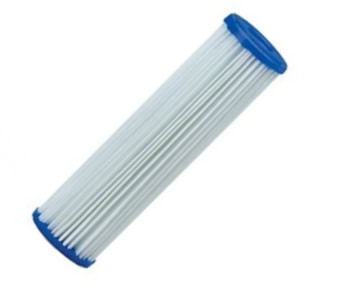
The primary benefit of using a pleated sediment filter (sometimes called accordion filters because of the way they look) is that there is much more surface area to the filter to allow the filter to capture more sediment before needing to be cleaned or replaced.
A second benefit is that the surface of the filter is thin to allow better water flow, which is very beneficial if your homes water pressure is relatively low to moderate.
Although the pleats on this type of filter do not look like all that big of a deal, there are so many of them that the benefit of the design is very substantial.
Also, when a pleated filter is placed into its filter container, it is compressed slightly which makes the pleats open up to allow better water flow and more exposed surface area.
Pleated sediment filters are commonly available in most hardware stores, but many of the ones that you may find are not necessarily the best ones for you to use.
Be sure to read the description on the label before you grab the first filter you see and head to the register. Here’s why!
Many pleated filters that you will find in your local hardware store are made from paper. They don’t call them paper filters, instead, they use the word “cellulose”.
Cellulose simply refers to an inert carbohydrate, (C6H10O5)n, the chief constituent of the cell walls of plants and of wood, cotton, hemp, paper, etc. (source)
The big problem with using a cellulose filter is that, just like paper that you would write on, cellulose filters can tear and allow the sediment that you are trying to filter out get through and into your home.
If a tear occurs on your sediment filter, small (or large) amounts of sediment can get passed the filter, clogging up sink faucets, toilet tanks, showerheads and more areas of the plumbing of your home.
I highly recommend using a pleated polyester sediment filter instead of a cellulose filter for several reasons.
1: A pleated polyester water filter is much more durable than a cellulose filter. The chance of a polyester filter tearing under normal conditions is much less likely than with a cellulose filter.
2: Although I don’t personally recommend re-using filters, a polyester filter is reusable, and many people simply rinse off and reuse polyester filters several times before replacing it.
If you choose to reuse any filter, keep in mind that they will not last forever, and the older the filter gets, the more likely it is to fail.
3: A pleated polyester filter is man-made and therefore the filtering surface will be more consistent and uniform than a filter made from organic material. This not only adds to the strength of the filter, but it also adds to the filters ability to consistently filter out the correct size particles that it is designed to filter.
Cellulose filters maybe a little cheaper than pleated polyester filters, but I have found pleated polyester filters right here on Amazon for a great price and they are certainly worth it.
If you consider the fact that you can reuse pleated polyester filters. Re-using them just once makes them a better value than using cellulose filters anyway.
Spun-Polypropylene sediment filters
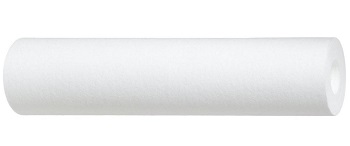
These are probably the most commonly thought of water filters when people think about a water filter. And that makes sense because they are used for a homes whole house filter and also used in many types of reverse osmosis drinking water systems.
Spun-Polypropylene filters are a finer filter than a pleated polyester filter, and therefore they are able to filter out smaller particles from the water.
So Spun-Polypropylene sediment filters are better right?
It’s not a matter of one being better than another, it’s about what you need to filter and how much water flow you require.
Using a Spun-Polypropylene sediment filter may sound like a better filter to use on the surface, but the surface of a Spun-Polypropylene sediment filter may be exactly what you don’t want to use if you don’t need to filter out tiny particles.
Think about it, if a Spun-Polypropylene sediment filter filters out smaller particles, then it must have smaller openings for your water to pass through.
The smaller the opening in the filter surface, the more restriction of water flow which results in lowered water pressure in the home.
Any home can have good or poor water pressure whether you have a private well or your water is supplied by municipal water supply.
Although not all Spun-Polypropylene sediment filters restrict water flow the same, they will generally restrict water flow more than a pleated polyester filter simply because of the additional surface area available on the pleated filter.
Spun-Polypropylene sediment filters commonly filter particles ranging between 1 and 25 microns in size. The smaller the micron number equals the smaller sized particles that the filter is able to filter.
This also means the more restriction of flow. So unless you have very small particles of sediment coming into your home, I highly recommend using a higher micron numbered filter to allow for better water flow.
In the event that non-dissolved iron is present in your water, you might need to use a smaller micron Spun-Polypropylene sediment filter.
This may cause a drop in water pressure once the filter has developed a layer of iron particles over its surface.
Rinsing the outside of the filter will often allow you to use the filter for a longer period of time between changes.
But I highly recommend having a few extra filters on hand for when the filter has been used to the point where it can no longer be rinsed and re-used.
For water containing non-dissolved iron, I recommend using a 5-micron filter like these recommended Spun-Polypropylene sediment filters that I found at a great price.
String-Wound sediment filters
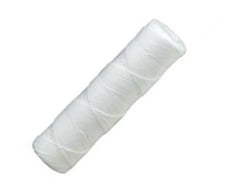
Winding fibers to create a filter has been around for a long time, weaving thread into cloth essentially makes a woven filter with threads fibers that have small openings between them which can allow air to pass through.
If you picture a loosely woven fabric like one of those bags that onions come in at the grocery store, that is essentially a filter.
It stops the onions from coming out and yet has large enough openings to allow you to see inside the bag to view the onions inside.
Now picture a butterfly net. The weave of a butterfly net is tighter so it can move through the air smoothly yet still hold the delicate butterfly within its net.
These are both examples of using a string or thread to create different sizes of filtration.
By winding string or threads that are spaced at different gap sizes between them, you can vary the density of the filtration, and even vary it as you wind the string.
A string wound sediment filter is wound around a central core where the weave is tighter and therefore able to filter out finer particles. Towards the outside of the filter, the weave is looser to filter out any larger particles.
This varying filtering of a string wound filter makes it useful when there are various sized particles in your water.
By having the outermost area of the filter only capture the larger particles and trapping the smaller particles deeper inside of the filter, the filter will not cause a drop in water pressure as fast as a filter that captures all sized particles on the outermost surface of the filter.
Dual-Gradient sediment filters
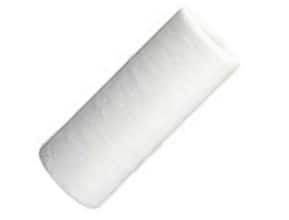
A Dual-Gradient sediment filter is very similar to a string wound filter as it can filter out smaller particles as they get closer to the center of the filter, but a Dual-Gradient sediment filter can do this more evenly and more uniformly.
Using a Dual-Gradient sediment filter works very well in situations where multiple sized particles are present, especially when there are both dissolved and non-dissolved iron in the water.
By having a uniform varying gradient filter, smaller particles can get captured deeper in the filter, leaving the outside of the filter to handle the larger particles.
Unlike wound string filters, Dual-Gradient sediment filters can filter a wider range of particle sizes and can be more easily made for different micron sizes and gradients.
Dual-Gradient sediment filters are both highly efficient and can hold a high amount of filtered material.
They can often be rinsed off and reused which makes them more affordable for situations where multiple sized particles are being filtered.
Bag sediment filters
A bag filter is just what it sounds like, it is a bag that is used to filter out a certain size particle that needs to be emptied or disposed of when it becomes full.
A bag filter is most commonly used for larger sediment or debris filtering. They are often used for filtering out debris that lands in a swimming pool such as small leaves or twigs.
Bag type filters are very useful as a first filtration stage of water that has a wide variety of different sized debris in it but are not very commonly used for average residential water filtering.
Carbon block filters
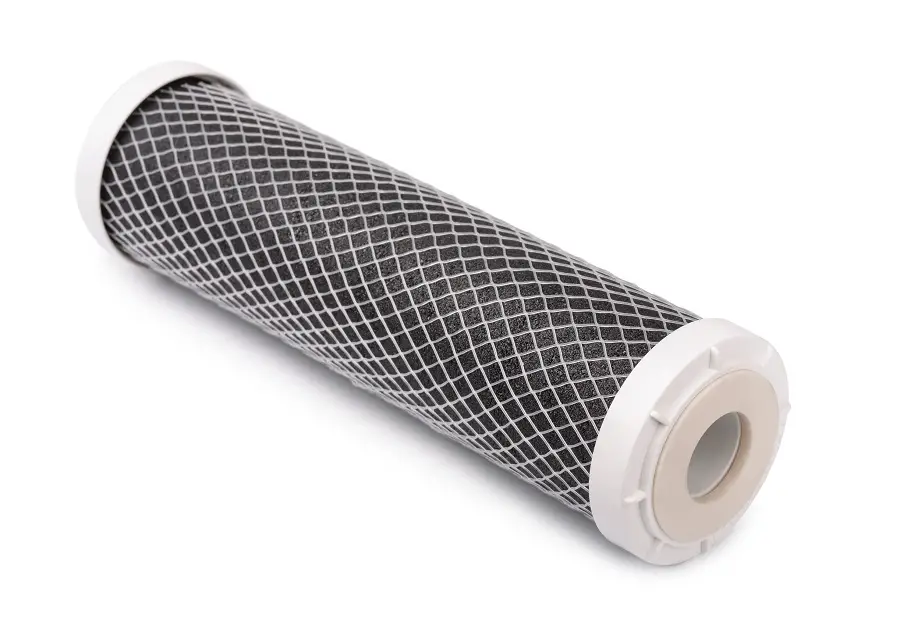
Carbon block filters come in 6 general categories, they differ in the size of the carbon particle size, how the carbon is processed before use in the filter, and type of carbon.
The 6 types of carbon filters are very similar and only vary slightly from one to another.
The 6 types of carbon filters most commonly used are:
Standard carbon block used for low to moderate reduction of chlorine commonly found in municipal water supplies, and helps to reduce unpleasant tastes and odors in the water being filtered.
Coconut carbon filters are used when odor and taste improvement is the primary goal.
Then there are specialty carbon filters that are designed for chloramine reduction, cyst reduction. lead reduction, and sediment reduction.
A Granular Activated Carbon (GAC) filter is different from a carbon block filter as it has carbon media inside of it for chemical, odor, and taste improvement in the water.
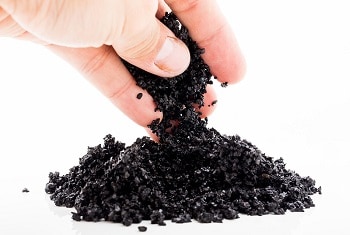
I highly recommend using a Granular Activated Carbon (GAC) filter if chlorine removal is your primary goal because the pure carbon inside will often remove higher levels of chlorine than a carbon block filter.
You can test for many of these contaminants yourself with a home test kit, but some contaminants need to be tested by a laboratory, and you should contact your local laboratory for proper testing.
Some of the more common substances that can be removed by using a carbon filter.
Acetone, Benzene, Calcium Hypochlorite, Chlorine, Herbicides, Insecticides, Iodine, Odor Causing Particles, PCB?s, Pesticides, Soap, Solvents, Tannins, Turpentine, VOCs, and Xylene.
See My Big List of Contaminants That Carbon Filtration Can Remove.
Do I need a sediment filter for municipal water?
Water coming from a city-wide municipal water source will normally be free of sediment, but having a sediment filter is still a good idea because of occasional sediment due to repairs on the municipal water delivery pipes.
A municipal water system has a huge array of pipes feeding a large amount of residence using the water. It’s just a matter of time before the municipal water supplier will have to do general maintenance or repairs on those pipes.
The water supply company may send you a flyer telling you when they will be doing work on your pipes, but that doesn’t mean that you will know if you may experience dirt or other debris in your water while this work is being done.
Broken pipes can mean dirt, rust, and even small twigs getting into your water supply, and these things will end up in your water softener, toilet tanks, washing machine, and even your drinking water and ice cubes if you don’t have a sediment filter stopping it when it first comes into your home.
I don’t recommend having the biggest sediment filter that you can get if you have a municipal water supply, you just need a simple, standard-sized in-line sediment filter. I found a perfect example of a basic sediment filter for municipal water right here on my recommended filters page.
It’s a great value, and easy to install yourself. If you feel that you need a larger filter, just check out my larger filter housings.
Do I need a carbon filter for municipal water?
More than likely, if your water is supplied to you by a municipal water suplier it has been treated with chlorine, and that chlorine is probably still present when the water comes into your home.
A carbon filter will filter out that chlorine and other small particles, protecting your clothes from fading, and your water fixtures from corroding.
You can get carbon filters for standard sized filter housings as well as for larger 4.5-inch diameter filter housings. See my recommended filter housings for more details on choosing the correct size filter housing for your home.
Do I need a whole house water filter when I have a water softener?

It’s important to understand that a water softener is NOT meant to be a water filter.
Sediment and other debris should be filtered from the water before getting to a water softener if there is a need for it.
Particles in the water can clog internal parts of a water softener, inhibiting its ability to soften your water.
This is especially true with a non-electric water softener that relies on rotating gears to monitor water usage and control the regeneration cycle of the system.
If sediment or debris gets lodged in these gears, the whole system can simply come to a stop, and it will not function until the blockage has been cleared.
This is one reason that I do not recommend non-electric water softeners when you have sediment in your water.
If you do have a non-electric water softener, I highly recommend installing a whole house filter before it, to protect it from sediment in the water that can lead to an expensive repair bill.
Why you need a sediment filter if you have an ultraviolet purification system.
An ultraviolet purification system uses light to disinfect the water that is passing through it.
In order to keep the ultraviolet light bulb from direct contact with the water, the bulb is located inside of a quartz tube in the center of the chamber of the system.
This clear tube (also called a sleeve or quartz) can get scratched by passing debris in the water or stained by iron and other contaminants in the water.
If the tube becomes etched or stained to the point where the light from the ultraviolet bulb can no longer pass through, the system will no longer be effective.
This is why any sediment or minerals should be filtered out of the water before it enters the ultraviolet purification system.
In most cases, using a 5-micron filter will remove any contaminants that will affect the system performance.
But if you have significant iron or hardness in your water, a water softener should be installed before the ultraviolet light to remove the hard minerals and iron.
Protect your reverse osmosis system from sediment, chlorine and other contaminants.
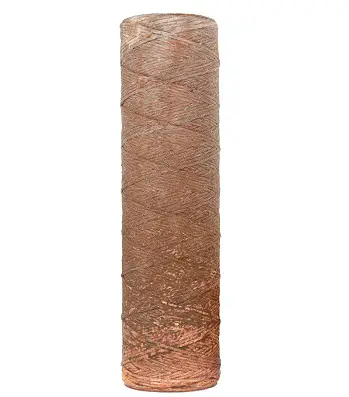
You are probably familiar with reverse osmosis drinking water systems. Matter of fact, most people either already own a reverse osmosis drinking water system or are looking into getting one.
Why? “Because they make your water better”.
Although most people simply have a reverse osmosis system underneath their kitchen sink for better quality drinking water, and some people have large reverse osmosis systems for their whole house.
Either way, a reverse osmosis system uses a semi-permeable membrane to remove dissolved solids from the water.
The reverse osmosis membrane is very delicate and can be easily damaged by particles or corrosive chemicals that can be in the water.
This is why it is so important to protect your reverse osmosis system from any sediment that may come from you’re well, and chemicals that may come from a municipal water supplier.
Any well can draw some sediment or fine silt into the home, and if this sediment gets to your reverse osmosis membrane, it can tear or puncture a hole in it.
Most reverse osmosis drinking water systems will come with a fine sediment filter. To see a few that are perfect for homes with private wells, see my recommended reverse osmosis systems.
If sediment is a problem with your well, having a whole house sediment filter will not only protect your reverse osmosis but your water faucets, showerheads, and appliances as well.
Municipal water suppliers will treat your water with chlorine to make it safe to drink. Unfortunately, the chlorine will make your water very un-safe for your reverse osmosis membrane.
Chlorine will deteriorate and ruin a reverse osmosis membranes ability to properly filter out dissolved solids from your water by weakening the membranes fibers. This will allow larger dissolved solids to pass through the membrane.
A carbon filter will remove chlorine from the water, leaving the water odor-free.
Not all reverse osmosis systems come with a carbon pre-filter for removal of chlorine, and chlorine in your water can make your entire home smell like a swimming pool.
A standard sized 2.5″ x 10″ Granular Activated Carbon (GAC) Filter will often do the job, but will need to be changed often and may not remove as much chlorine when the water demand in the home is high.
I always recommend using a larger 4.5″ x 10″ or even a 4.5″ x 20″ Granular Activated Carbon (GAC) Filter for chlorine removal in the home because it will handle a higher flow of water with less drop in water pressure, and need changing much less often.
Selecting the best size filter housing for your home.
Flow rate:
How many Gallons Per Minute (GPM) do you need to properly supply your home?
When considering how much volume of water you may be using at any one time, think about everything in your home that uses water operating at once.
Every shower running, every sink flowing, every toilet flushing, and every outside spigot watering.
That sounds like a huge amount of water, right!
Well don’t panic, you will almost never have that much water being used at one time in your home, but it is something to consider when choosing the correct sized whole house water filter for your home.
If you only have 2 full baths and a kitchen sink with 2 people living in the home, with very little particle filtering needed, a standard-sized filter housing will suit your needs just fine.
On the other hand, if you have a much larger home with 3 full baths, 2 half baths, and 2 kitchens, your going to have to look into a bit bigger whole house filter system.
With a high water volume home, you will need a high water volume filtering system, like a dual 4.5″ x 20″ to provide your home with the absolute highest volume of filtered water possible.
To get a simple estimate of how much water demand your home may require, USGS.gov estimated that the average adult uses between 80 and 100 gallons of water per day when you consider bathing, toilet flushing, laundry, drinking, etc. (Source)
When calculating your estimated volume based on this average, consider anyone in the home 12 years of age and up as the amount of water used by a teen is about the same if not more than an adult over the age of 18.
Filter size and micron size:
Both of these factors are very important to consider when choosing a whole house filter. The smaller the micron rating of a filter, the more potential water pressure loss possible.
If you just have small sand-like particles coming up from you’re well, a 30 or even 50-micron filter should work just fine, and still give you great water flow.
If you must use a finer filter because of fine silt or iron particles in your water, using a larger size filter may be the better solution.
Home water filter cartridges most commonly come in 2.5″ and 4.5″ diameters.
The 4.5 diameter cartridge will have more surface area on it which translates to a longer time before the particles in your water will affect the water flow through it.
These two filter sizes also come in two common lengths. The most common length is a 10″ filter (some filters are actually just a bit shorter than 10 inches, but they are still called 10-inch filters and work the same as an actual 10-inch filter).
These are by far the most commonly found filters used in most homes, but if you have a lot of sediment in your water or require a large volume of water, then you may consider upgrading to a 20″ length filter.
A 20″ long filter is available in both 2.5 and 4.5 diameter sizes and will allow the maximum water flow with the least frequent need to change.
Check out my recommended whole house filter housings and my recommended whole house filter cartridges for more details.
Port size of filter housing:
A standard sized 10″ x 2.5″ filter housing will most often come with 3/4″ ports for standard sized 3/4″ plumbing.
This sized filter will work well for most situations, but if you are looking to maximize your potential water flow, a 1″ port will provide the best flow with the least noticeable drop in pressure.
Unwanted substances in your water, and how they can be removed with the correct filter.
Not all well water is the same and even municipal water supplies will have different contaminants in it that you will want to remove from the water to make it safer and more enjoyable for you and your family.
There are several different types of drinking water contaminants in water such as:
Physical contaminants like sediment or other non-dissolved material in water. These can be removed by a basic sediment filter with the correct micron size for the type of particle being removed.
Chemicals in the water either from natural organic materials or synthetic compounds produced by a man-made process. Many chemicals can be removed by using a Granular Activated Carbon (GAC) Filter.
Biological contamination which are organisms living in water that can be considered unhealthy to consume.
The best way to protect yourself against harmful organic material in water is with the use of an ultraviolet water purifier.
Using ultraviolet light, a UV purifier will sterilize your water, making it safer to drink.
Radiological chemical elements emitting radiation that can be harmful.
You will need to have your water tested to identify and radioactive elements contained in it, and all radiological element are not treated in the same way. (Source)
Which Drinking Water Filters Are Best For You?
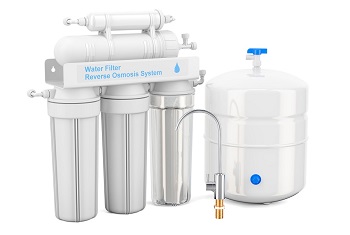
A reverse osmosis drinking water system is a great addition to any home.
Having high-quality drinking water available to you and your family at the turn of a faucet lever encourages you and your family to drink more water which is so important to your health.
Before purchasing a reverse osmosis drinking water system you need to consider what is in your water, and what you want to remove from it.
Getting a simple to use Do it yourself water test kit will help you understand issues in your water that you may want to address. The primary function or reverse osmosis is to remove dissolved solids from your water.
The Total Dissolved Solids (TDS) in your water is an indication of any solids that are present in your water, but I have found the most common concern that people have about their drinking water is the amount of salt in their water.
In many cases, the Total Dissolved Solids in your water is primarily salt, depending on your location of course.
The process of reverse osmosis does a great job at removing salt from water, and in most cases, a reverse osmosis system will remove up to 98% of salt from your water.
How you can measure the approximate amount of Total Dissolved Solids in your water.
Using a TDS meter will give a reading of estimated Total Dissolved solids in your water-based on the electrical resistance in your water. Although a TDS meter does not determine the TDS contained in water, it does give a good approximation.
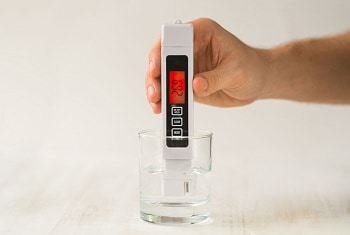
Testing the TDS of your regular tap water will help give you an idea about how good your water should be with a reverse osmosis system.
Take 5% of the TDS that you found in your tap water, and that will be about the number of TDS that you should have with a reverse osmosis system.
What type of stage (filter) your new reverse osmosis system should have will depend on where your water is coming from and what is in it.
Basically, water coming from a well can contain some sediment or other types of debris in it which is why a sediment filter should be the first stage of a reverse osmosis system if you have a private well.
Municipal water will be treated for harmful organic material that may be contained in it, and this is usually done by adding chlorine to the water.
Chlorine disinfects water very well, but it can also ruin a reverse osmosis membrane.
This is why if your water comes from a municipal water source, your reverse osmosis system should have a carbon filter stage before the water gets to the reverse osmosis membrane.
In some cases, you could be receiving your water from a municipal water source that also has some sediment in the water.
This is when I highly recommend having a whole house sediment filter to not only protect your reverse osmosis system but your entire home as well.
Having a whole house carbon as well will also help to protect your reverse osmosis system from fluctuations in the level of chlorine that your water is being treated with.
Municipal water suppliers will occasionally introduce a very high dose of chlorine to the water to ensure a thorough sanitization of the water system.
This large level of chlorine can be too much for a small carbon filter on your reverse osmosis system to handle.
Benefits Of A Whole House Water Filter.
The answer to this question is very simple, to remove unwanted contaminants from your water.
Well, that seems kind of obvious, but that is exactly what any water filter is for.
The real benefits of having a whole house water filter are to protect your entire home from sediment, chemicals, odors, and bad tastes that may be in your water.
The second major benefit is a larger whole house filter needs to be changed less often than a small filter that is used for only one location of the home.
A third, and maybe the most important benefit of having a whole house filter is that a larger filter may be needed for the quantity of the substance that you are trying to remove from your water.
See my recommended whole house filters for a better idea of what sized whole house filter may be best for your needs.
Advantages of Carbon-Based Whole House Water Filters.
As I have already mentioned earlier, carbon filtration is commonly used for the reduction of chlorine used to disinfect water. But carbon is also great for reducing other chemicals and very small particles in your water.
Odors and odd tastes in water are usually due to very tiny particles in your water that even a very fine sediment filter will not filter out.
Can I install a whole house filter myself?
You Sure Can!

If your not a plumber or a weekend DIY person, installing a whole house water filter may seem rather intimidating.
But if you think about, all you have to do is shut your water off, cut a section of your water pipe out, and insert the water filter.
Yes, that sounds a little too simplified, but that is essentially it.
Shutting off your water only involves turning a valve or moving a handle.
Cutting a copper pipe is very simple and quick with an inexpensive pipe cutter, and with plumbing fittings easier to use than ever, you don’t even have to use a torch anymore.
The average person can have a whole house filter completely installed in very little time with a few shutoff valves, a pipe cutter, quick connectors, some plumbers sandpaper, and a little bit of silicone-based lubricant.
Do whole house water filters reduce water pressure?
Anytime you add any filter or water treatment system to your plumbing, it will cause resistance and may cause a drop in water pressure.
If your water pressure is only satisfactory, to begin with, be very careful to only add necessary water treatment equipment to your home, and be sure to use the correct whole house filter.
Using a filter cartridge that is designed to filter out particles that are 1 micron in size, will create a greater drop in water pressure than on that is for 50 micron-sized particles.
Only use the filter micron size that you need, and change your filter cartridge regularly to prevent loss of water pressure to your home.

